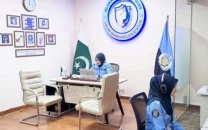South Asian rivalries may hinder region’s economic progress
Speakers say regional countries need to change their attitudes towards each other for progress

PHOTO: REUTERS
This was stated by Indian intellectual Sudheendhra Kulkarni as he explored ideas on connectivity and regional cooperation on the first day of a regional conference on “Connectivity and Geo-Economics in South Asia.” The conference had been organised by Pakistan Institute for Peace Studies (PIPS) in Islamabad on Wednesday.
“[South Asia] is the most populated, least integrated and one of the poorest regions of the world,” Kulkarni said, adding that trade amongst South Asian countries often circumvents each other, passing through third countries.
India calls satellite 'gift to South Asia', Pakistan says no thanks
Speakers at the conference pointed out that rivalries and stereotypical perceptions about each other have been hampering connectivity and trade.
Should the region want to draw on the collective benefits of each other’s resources, particularly to make use of the China-led Belt and Road Initiative (BRI), participants said that these attitudes will have to change.
Speakers discussed the policy implications of projects like the BRI and the China-Pakistan Economic Corridor (CPEC) and what would be the impact of supplementing these efforts with enhanced cultural contacts and cross-border economy.
Former Awami National Party (ANP) Senator Afrasiab Khattak questioned the wisdom of closing the border with Afghanistan, particularly since substantial money has been spent on developing.
He wondered if this policy even resonates with the goal of connectivity.
Participants also hinted it was partly to attain a similar goal that Pakistan and Afghanistan established a bilateral crisis management mechanism.
PIPS Director Muhammad Amir Rana credited Chinese diplomatic efforts for helping normalise those relations, underway since 2016, but went on to ask if China can facilitate a similar channel with India.
Some raised the suspicion that Iran’s Chabahar port is meant to out and even undo Pakistan’s Gwadar port.
At this, Khattak said there was a need to overcome the zero-sum game and move towards a win-win order.
Chinese Scholar Wang Xu argued that there seem to be conceptual differences about the purpose of this project.
“We need to move from geopolitics to geoeconomics,” noted Khattak. Scholar Fazlur Rehman, however, hinted this was easier said than done since the BRI was being perceived by some — especially by those in the West — as an attempt to gain political advantage, especially in the west.
Some participants called for reviving the region’s oldest connectivity platform, the South Asian Association for Regional Cooperation (SAARC).
SAARC Development Fund commences infrastructure funding in SAARC region
Nepal’s Sangroula even wondered if, without SAARC, the dividends of China’s BRI can really pay off.
The conference also touched on the domestic interface of regional connectivity projects.
In the context of CPEC, it was discussed that its domestic goal was to uplift the people economically. Hence, it was subject to heated debates on which province in Pakistan will benefit most from CPEC.
Former Pakistan Peoples Party (PPP) senator Taj Haider, who also headed a special committee on CPEC, said that when it came to choosing sites of CPEC projects, the question was: “Shall we connect the areas that are already connected? Or shall we connect those that are underdeveloped?”
Published in The Express Tribune, June 28th, 2018.


















COMMENTS
Comments are moderated and generally will be posted if they are on-topic and not abusive.
For more information, please see our Comments FAQ